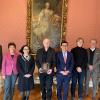
A new Horizon Europe project coordinated by IIASA will provide a novel governance model based on multi-level stakeholder dialogues spanning the European Commission, through national and local administrations down to citizens, as well as the necessary tools for co-designing agriculture, forestry, and climate policies in support of the EU’s climate neutrality target.
As part of the European Green Deal, and in line with the European Climate Law, the EU has set itself a binding target of achieving climate neutrality by 2050. In this regard, the land use sector, which is the only sector that is readily available to compensate for unabated greenhouse gas emissions from other sectors through carbon sequestration, and is in fact already removing 7% of all EU emissions, has a key role to play.
Land use choices that enhance our ability to capture and store carbon on land – known as the terrestrial carbon sink – interact with other societal goals. For instance, the land required for planting additional trees can also be in demand for agricultural production to ensure EU food security, infrastructure to contribute to economic growth, or nature conservation to keep biodiversity intact. EU policies that determine how land is used thus need to be carefully designed in an integrated approach accounting for the diverse societal demands and the synergies and trade-offs among them.
The Land Management for Sustainability (LAMASUS) project, an ambitious new pan-European research project funded under the Horizon Europe Program, brings together *17 research institutions from eight EU countries to produce tools and design processes allowing EU policymakers to assess the impacts of future policies ahead of their implementation and so make informed choices for European agriculture and land use, as well as the global climate.
The project builds on established modeling tools such as GLOBIOM, CAPRI, MAGNET, and CLUE, which are used to predict the impacts of climate, agricultural, and forestry policies, at the local, national, and regional levels.
“We’ve known for some time that decisions on how land is used are made at the local, regional, and national levels, and are affected by their impacts on climate change, food security, biodiversity, and agricultural income. LAMASUS is the first attempt to allow us to project these impacts at different levels, by combining all these tools in a way that uses their strengths,” explains Tamás Krisztin, scientific coordinator of the LAMASUS project and a researcher in the IIASA Integrated Biosphere Futures Research Group.
The project will also provide guidance for the formulation and implementation of Green Deal policies. The partners will create an online interface, enabling – through visualizations of policy impacts – the dialogue between the European Commission, member states, regional policymakers, and land-users. The designers hope that the platform will incentivize the use of the tools to as wide an audience as possible.
“We are developing tools that can help the European Commission, its member states, and regional decision makers come to agreements about the impacts of their actions in terms of future emissions from use of land for agriculture and forestry,” adds Krisztin.
To enable these tools, LAMASUS proposes a framework for a unified high-resolution land-use mapping and monitoring strategy. This requires frequent updates of associated databases for European land-use and EU agricultural and forest related policies. The project contributes by combining state-of-the-art remote-sensing methods with machine learning tools and European statistical datasets. The project will also provide an enhanced understanding of past and current land-use dynamics, drivers, and impacts. The team’s work will focus on the role of EU land-related policies and will close knowledge gaps in the economic and environmental impacts of associated farming and forestry practices.
The key drivers identified will inform the LAMASUS Modeling Toolbox: a collection of established policy assessment models in agriculture, forestry, and land use. It is foreseen that the project will boost economic and environmental ex-ante modeling across spatial scales by upgrading and integrating policy impact assessment models for agriculture and forestry to adequately represent both top-down and bottom-up environmental and economic feedbacks. The toolbox will be presented on an easily accessible web interface, which connects policymakers from different countries with local actors, and informs their policy choices through quantitative mid- to long-term projections of agriculture and forestry policy impacts
“LAMASUS will create a new level of societal engagement in which local actors contribute to the design of effective and efficient EU policies for climate neutrality and serve as an exemplar for other policy processes within the European Green Deal,” concludes LAMASUS principal investigator and IIASA Integrated Biosphere Futures Research Group Leader, Petr Havlík.
* The LAMASUS consortium consists of 17 partners from eight countries in Europe (Austria, France, Germany, the Netherlands, Norway, Spain, and Switzerland).
- International Institute for Applied Systems Analysis (IIASA) – coordinator
- University of Bonn (Rheinische Friedrich-Wilhelms-Universität Bonn)
- European Centre for Agricultural, Regional and Environmental Policy Research - EUROCARE GmbH
- Stichting Wageningen Research
- National Research Institute for Agriculture, Food and Environment (INRAE)
- Ruralis - Institute for Rural and Regional Research
- Johann Heinrich von Thünen Institute
- University of Natural Resources and Life Sciences (Universität für Bodenkultur Wien)
- PBL Netherlands Environmental Assessment Agency
- Vrije Universiteit Amsterdam
- University of Valencia
- University of Warsaw
- ARTTIC Innovation GmbH
- Joint Research Centre
- Zurich University of Applied Sciences/ZHAW
- University of Paris-Saclay
- Austrian Institute of Economic Research (WIFO)
News

21 February 2025
Vietnamese Ambassador and IIASA discuss strengthening research collaboration

10 February 2025
Systems analysis to tackle the monopolistic power in the era of AI

10 February 2025


